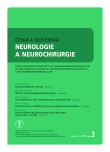Kennedy’s Disease in the Neuromuscular Centre in Bratislava
Authors:
F. Cibulčík 1; I. Martinka 1; A. Hergottová 1; I. Urminská 1; R. Petrovič 2; H. Zelinková 2; P. Špalek 1
Authors‘ workplace:
Neurologická klinika LF SZU a Centrum pre neuromuskulárne ochorenia, UN Bratislava
1; Ústav lekárskej biológie, genetiky a klinickej genetiky, LF UK a UN Bratislava
2
Published in:
Cesk Slov Neurol N 2015; 78/111(3): 335-339
Category:
Short Communication
doi:
https://doi.org/10.14735/amcsnn2015335
Overview
Background:
Kennedy´s spinal and bulbar muscular atrophy is a hereditary disease and the most common form of spinal muscular atrophy in adult age. This disease is caused by a CAG - repeat expansion in androgen receptor gene on the X-chromosome.
Aim:
A comparison of clinical and genetic characteristics of our patients with patients in three large studies available from Japan, USA and Great Britain.
Methodology:
Between 1990 and 2013, we observed 17 patients with genetically verified diagnosis of Kennedy´s disease. We ascertained detailed medical history, all patients had neurological, electrophysiological and laboratory examinations, including genetic testing using PCR methodology.
Results:
The majority of parameters were similar to data from foreign studies – the mean age at the time of data collection was 53.6 ± 9.7 years and 43.1 ± 8.1 years at the time of first symptoms, the mean time from onset of symptoms was 9.2 ± 7.7 years and the mean time from onset of symptoms to diagnosis was 5.2 ± 4.6 years. Initial disease symptoms occurred, similarly to the other studies, in proximal parts of the lower extremities (47% of patients), followed by bulbar region (17%) and the muscles of the upper limb (12%). Compared to other studies, fewer patients (35%) had a positive family history, while the average CAG repeat size was similar (44.4 ± 3.2). We have identified a very strong correlation between the number of CAG repeats and the maximum detected value of creatine kinase and a strong correlation between the duration of the disease and maximal detected value of creatine kinase.
Key words:
Kennedy´s disease – spinal muscular atrophy – myastenia gravis
The authors declare they have no potential conflicts of interest concerning drugs, products, or services used in the study.
The Editorial Board declares that the manuscript met the ICMJE “uniform requirements” for biomedical papers.
Sources
1. Kennedy WR, Alter M, Sung JH. Progressive proximal spinal and bulbar muscular atrophy of late onset: a sex‑linked recessive trait. Neurology 1968; 18(7): 671– 680.
2. LaSpada AR, Wilson EM, Lubahn DB, Harding AE, Fischbeck KH. Androgen receptor gene mutations in X‑linked spinal and bulbar mucular atrophy. Nature 1991; 352(6330): 77– 79.
3. Mayer M, Kojecký Z, Urbánek K, Bartoušek J, Vlachová I. Kennedyho choroba – méně obvyklá forma spinální svalové atrofie. Cesk Slov Neurol N 1995; 58/ 91(4): 180– 183.
4. Atsuta N, Watanabe H, Ito M, Banno H, Suzuki K, Katsuno M et al. Natural history of spinal and bulbar muscular atrophy (SBMA): a study of 223 Japanese patients. Brain 2006; 129(6): 1446– 1455.
5. Rhodes LE, Freeman BK, Auh S, Kokkinis AD, La Pean A,Chen Ch et al. Clinical features of spinal and bulbar muscular atrophy. Brain 2009; 132(12): 3242– 3251. doi: 10.1093/ brain/ awp258.
6. Fratta P, Nirmalananthan N, Masset L, Skorupinska I, Collins T, Cortese A et al. Correlation of clinical and molecular features in spinal bulbar muscular atrophy. Neurology 2014; 82(23): 2077– 2084. doi: 10.1212/ WNL.0000000000000507.
7. Guidetti D, Sabadini R, Ferlini A, Torrente I. Epidemiological survey of X‑linked bulbar and spinal muscular atrophy, or Kennedy disease, in the province of Reggio Emilia, Italy. Eur J Epidemiol 2001; 17(6): 587– 591.
8. Lee JH, Shin JH, Park KP, Kim IJ, Kim JG, Lim JG et al. Phenotypic variability in Kennedyś disease: implications of the early diagnostic features. Acta Neurol Scand 2005; 112(1): 57– 63.
9. Sorarú G, D’Ascenzo C, Polo A, Palmieri A, Baggio L, Vergnani L et al. Spinal and bulbar muscular atrophy: skeletal muscle pathology in male patients and heterozygous females. J Neurol Sci 2008; 264(1– 2): 100– 105.
10. Yamada M, Inaba A, Shiojiri T. X‑linked spinal and bulbar muscular atrophy with myasthenic symptoms. J Neurol Sci 1997; 146(2): 183– 185.
11. Stevic Z, Peric S, Pavlovic S, Basta I, Lavrnic D. Myasthenic symptoms in a patient with Kennedy’s disease. Acta Neurol Belg 2014; 114(1): 71– 73.
12. Inoue K, Hemmi S, Miyashi M, Kutoku Y, Murakami T,Kuokawa K et al. Muscular fatigue and decremental response to repetitive nerve stimulation in X‑linked spinobulbar muscular atrophy. Eur J Neurol 2009; 16(1): 76– 80. doi: 10.1111/ j.1468‑ 1331.2008.02349.x.
13. Boz C, Kalay E, Sahin N, Velioglu S, Ozmenoglu M, Karaguzel A. Ocular myasthenia gravis associated with X-linked recessive spinal and bulbar muscular atrophy. J Clin Neuromuscul Dis 2004; 5(3): 115– 118.
14. Jokela M, Udd B, Päivärinta M. Double trouble: spinal muscular atrophy type II and seropositive myasthenia gravis in the same patient. Neuromusc Disord 2012; 22(2): 129– 130. doi: 10.1016/ j.nmd.2011.07.011.
15. Katsuno M, Tanaka F, Adachi H, Banno H, Suzuki K, Watanabe H et al. Pathogenesis and therapy of spinal and bulbar muscular atrophy (SBMA). Prog Neurobiol 2012; 99(3): 246– 256. doi: 10.1016/ j.pneurobio.2012.05.007.
Labels
Paediatric neurology Neurosurgery NeurologyArticle was published in
Czech and Slovak Neurology and Neurosurgery

2015 Issue 3
Most read in this issue
- Addenbrooke’s Cognitive Examination – Approximate Normal Values for the Czech Population
- Spinal Shock – from Pathophysiology to Clinical Manifestation
- Diagnosis of Epileptic Seizures
- Air Embolism of the Brain – a Case Report
